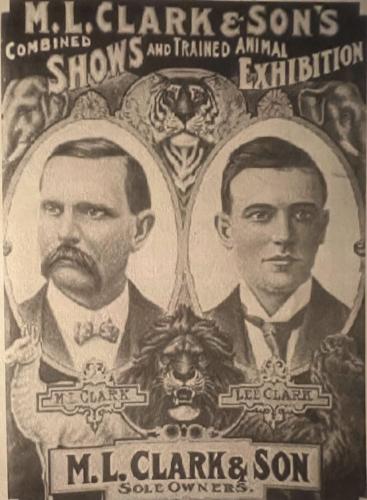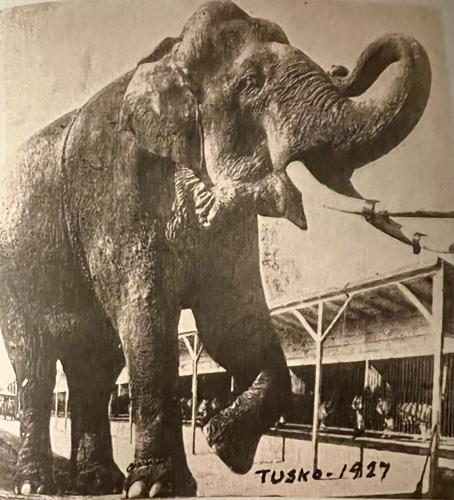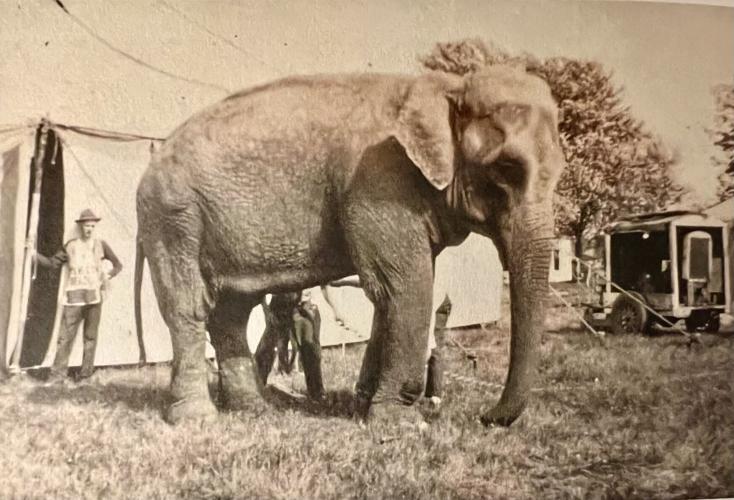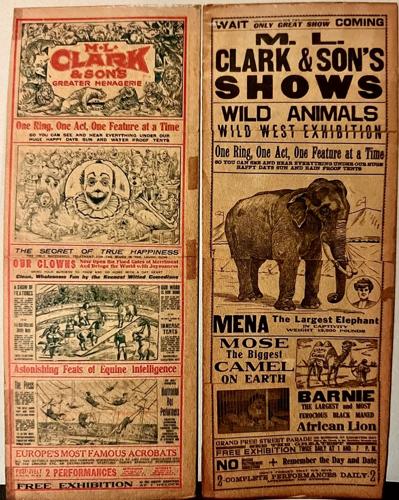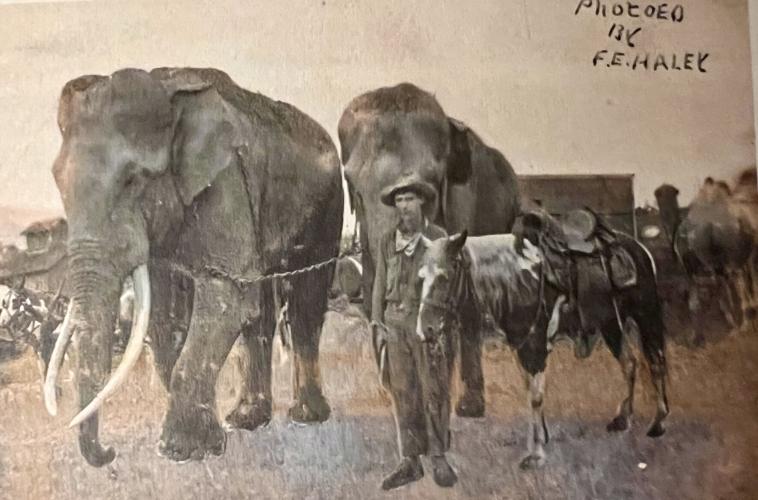
A lithograph poster for the M.L. Clark and Son's Circus. The circus, known a the "Greatest Little Show in the United States," was based in Alexandria.
Hurry, hurry, hurry! Step right up to the greatest show on Earth by way of Louisiana.
Well, sort of.
This "greatest show" actually started in Burleson County, Texas, then anchored itself in central Louisiana while garnering international fame.
Not national — international.
Which is something that perplexed author Bill Sumrall when he happened upon an old newspaper advertisement for an Alexandria-based circus while researching a subject that had nothing to do with the traveling show.
But that's what usually happens during research — one rabbit hole leads to another. And Sumrall knew he had to find out more about the M.L. Clark and Son's Circus, which was based in his hometown.
"Was there really a circus in Alexandria?" he asked.
Alexandria historian and author Michael D. Wynne accidentally discovered the circus while researching an unrelated historical topic. He didn't hesitate jumping into that rabbit hole, where he quickly learned that there was indeed, such a show.
In fact, he learned more than that.

A lithograph poster for M.L. Clark and Sons Circus. The circus, known a the "Greatest Little Show in the United States," was based in Alexandria.
"I came across this little reference in an old edition of The Alexandria Daily Town Talk, and it said there was a circus that was headquartered in Alexandria," Wynne said. "The more digging, the more I unearthed. This was a circus known not only around North America but also in Europe. It was nicknamed the 'Biggest Little Circus in America'."
Still, to learn the full story of this show, Wynne had to backtrack to its origins east central Texas, where the circus' founder, Mack Loren 'M.L.' Clark, was living and running a show that was more aligned with scoundrels than rings beneath a big top.
"It all started with M.L. Clark's older brother, Wiley C. 'W.C.' Clark," Wynne said. "W.C. was a scoundrel. He started his show in the 1880s, and his show included a minstrel show and a hairy woman, both of which were ridiculous. They had a show with all kinds of magic tricks, and they added some animals along the way."
Back then, there were two types of circuses. P.T. Barnum's would have been called a train circus, because he transported his performers and animals by train.
The second kind was much cheaper to operate.
"The other kind of circus was known as was a mud circus, because everything was transported by wagons along muddy roads," Wynne said. "And the circus hired these roustabouts, who were almost all criminals. They were people on the run. One roustabout robbed the mail train between performances."
The Clark Brothers Circus dissolved in 1892 with the departure of the elder Clark brother, who purchased a hotel in the Indian Territory of Akota, which eventually became the state of Oklahoma.

Tusko, known as Old Ned at the time he was part of the M.L. Clark and Son's Circus, is shown in a 1917 photo. He was known as the world's biggest elephant in captivity. His sidekick, Mena, almost matched his size.
After a few reiterations, M.L. Clark restructured the show, renaming it M.L. Clark and Son's Circus. The "son" in the title was for his son, Lee. The show traveled the width and length of the United States and even ventured into Canada.
Fast forward to 1899, when Clark purchased a lot opposite the Union Depot in west Alexandria as a headquarters for his show — and a place to spend the winters.
"The Barnum and Bailey circuses were always headquartered in Florida in the winter, because it was warm there, and they had to keep the animals warm," Wynne said. "The M.L. Clark Circus headquartered in Alexandria, where they had performed as early as 1884. They just liked it there."
Among the circus' items that wintered in Alexandria were its two elephants, Mena and Tusko, also known as "Old Ned," when he was purchased by the Clark Circus in 1902.
Both were said to be the world's largest elephants in captivity. Documentation in 1932 showed Ned standing at 10 feet, 2 inches high and weighing 7 tons, 313 pounds. The circumference of his tusks were 17½ inches, and the circumference of his leg at the base of his foot was 65 inches.
The distance between his eyes measured 2 feet, 9 inches, and the distance from his rear to the end of his trunk was 18 feet, 11 inches.

Mena was one of two large elephants in the M.D. Clark and Son's Circus based in Alexandria. The elephants were known as the world's largest elephants in captivity.
By that time, Tusko was living in the Woodland Park Zoo in Seattle, Washington — after developing a reputation for going on mad rampages after being sold to the Al B. Jones Circus. He died in 1937 at age 42.
Mena, whose size was comparable to Tusko's, was known for her gentle temperament. "Big" Bill Thompson even put her to work on his campaign when he ran for mayor of Chicago in 1931.
Mena was sold to the Royal Brothers Circus in 1938.
"But the people of Alexandria wanted her back," Wynne said. "In 1943, they collected nickels and pennies from the children in town and raised $300 to bring her to the Alexandria Zoo. She used to let children pet her, and she was still beloved by them. But Mena was getting old by that time, and she died before they could bring her back to Alexandria."
During its Alexandria heyday, M.L. Clark bought up all of the land at the northern part of Alexandria to provide for the animals in his show.
"They put up permanent buildings and tents, and the families had to live in tents, including M.L. Clark's own family," Wynne said. "One of the great stories is how M.L. Clark's wife said she was tired having to live in a tent while the cows and the horses and everybody else lived in a barn, because Clark took better care of them than he did his own family. So, his wife she ordered the first prefabricated house ever to come to Louisiana."

Advertisements for the M.L. Clark and Son's Circus based in Alexandria. The circus operated from the 1890s to 1930.
That was in 1907. She ordered it out the Sears and Roebuck catalog.
"It was set up on Monroe Street," Wynne said. "That house existed until the Sunset Street housing complex was created. But Clark's second house on Monroe Street, which is much more modern, that the family lived in, is still there."
Wynne documents all of these stories in his 2022 book, "Hurry, Hurry, Hurry, Step Right Up to the Greatest Show on Earth!: The True Story of the 'Largest Little' Circus in the United States — The M.L. Clark and Son's Circus."
As indicated in this title, the circus was nicknamed the "Largest Little Circus in the United States."
Wynne also documents some known names who passed through the circus along the way, including jazz trumpeter Harry James' grandfather, who served as the circus' bandleader.
"Harry James' parents worked for the circus, too," Wynne said. "His father played trumpet in the band, and his mother was an acrobat."

Tusko, foreground, and Mena, the famous elephants of M.L. Clark and Son's Circus. The elephants were known as the world's largest elephants in captivity.
Tom Mix, who later went to Hollywood to become a star in early westerns, was an animal caretaker for the circus.
Clark died in 1926, but as goes the old adage, the show went on when his son, Lee Clark, stepped in as boss. Lee Clark ran the show until he finally sold the circus in 1930 to E.E. Coleman of Dayton, Ohio, and moved back to Alexandria.
So, the spotlight faded, and the curtain closed on Alexandria's part in the "Greatest Little Circus in the United States."
"But it was an incredible circus," Wynne said. "It was nothing like you would see in the movies, but the newspapers documented everything back then. And from those accounts, it was a great show."


